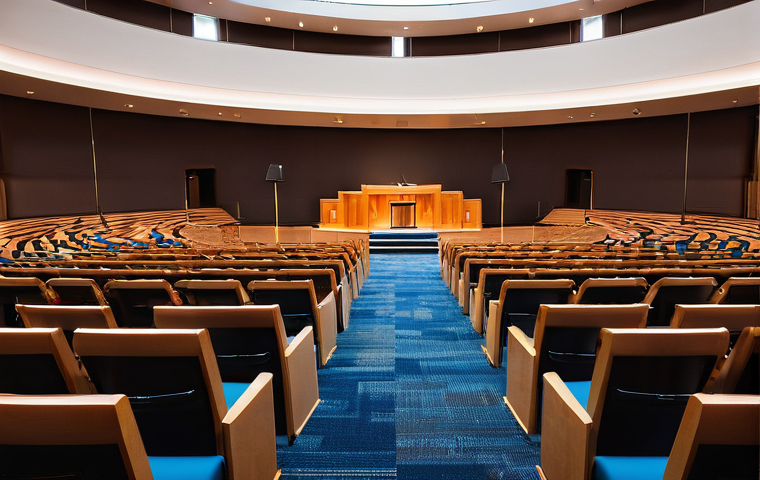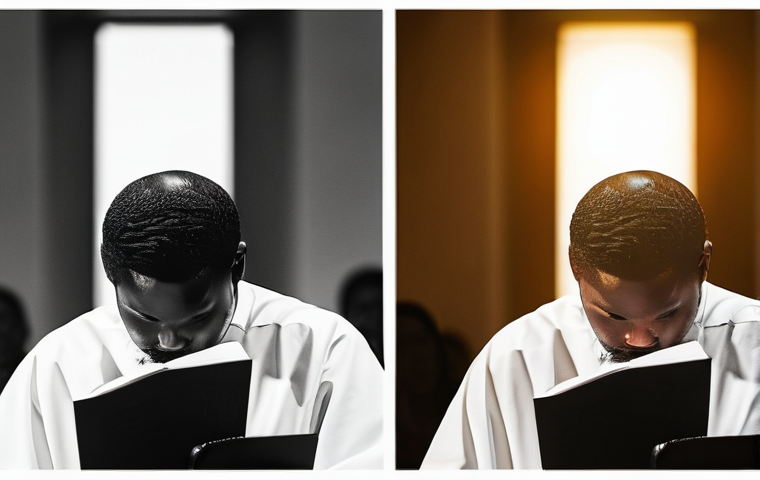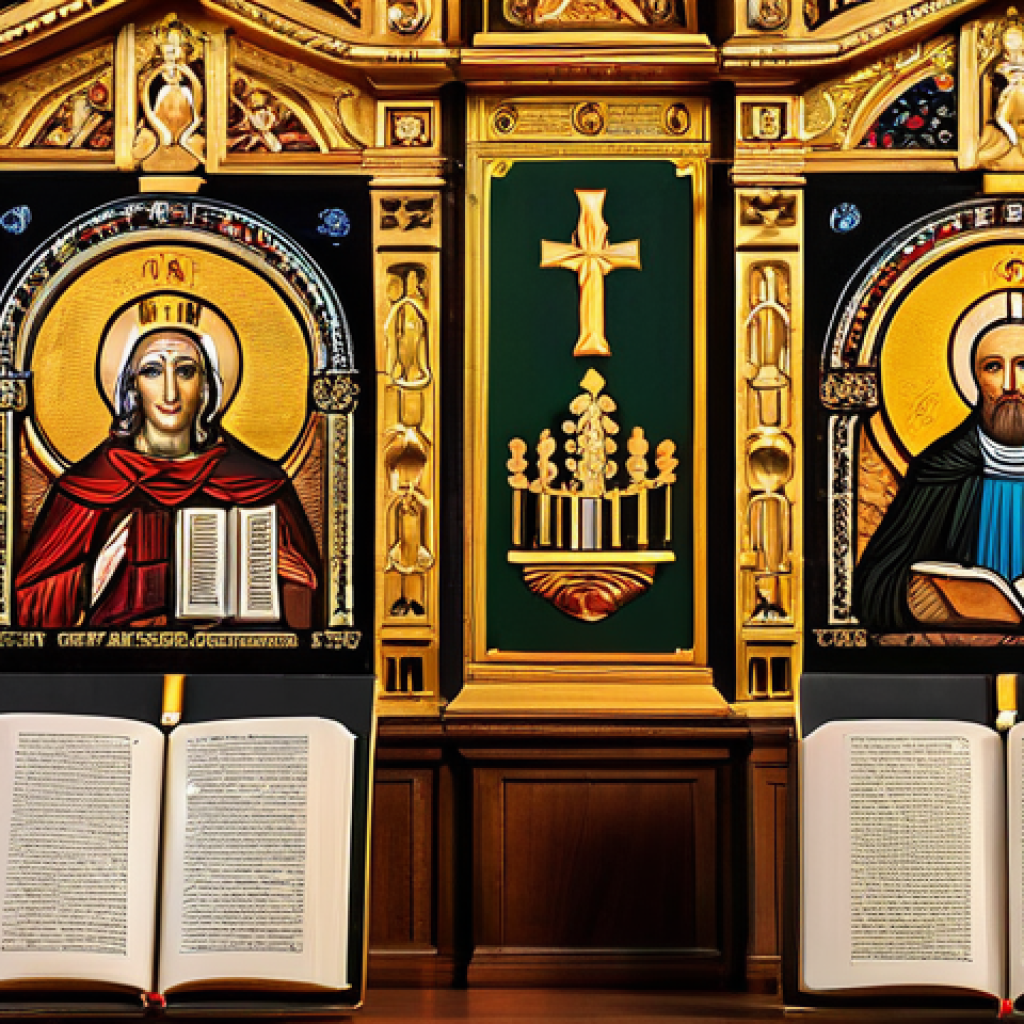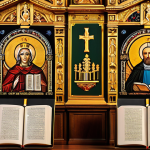Ever wondered about the subtle – and sometimes not-so-subtle – differences between Protestantism and Catholicism? I know I have! It’s a topic that often sparks curiosity, given that both are major branches of Christianity, yet they’ve evolved with distinct traditions, practices, and interpretations.
Many of us grow up hearing about them, maybe even attending services, but a deep dive into what truly sets them apart can be surprisingly insightful, revealing centuries of history and theological development.
If you’ve ever felt a bit confused or just wanted to understand your friends’ or neighbors’ beliefs a little better, you’re definitely not alone. Let’s peel back the layers and truly understand these fascinating distinctions together.
Ever wondered about the subtle – and sometimes not-so-subtle – differences between Protestantism and Catholicism? I know I have! It’s a topic that often sparks curiosity, given that both are major branches of Christianity, yet they’ve evolved with distinct traditions, practices, and interpretations.
Many of us grow up hearing about them, maybe even attending services, but a deep dive into what truly sets them apart can be surprisingly insightful, revealing centuries of history and theological development.
If you’ve ever felt a bit confused or just wanted to understand your friends’ or neighbors’ beliefs a little better, you’re definitely not alone. Let’s peel back the layers and truly understand these fascinating distinctions together.
The Fabric of Worship: Liturgy and Personal Connection

Stepping into a worship service, you immediately get a feel for the unique atmosphere. For me, coming from a background where services often felt more structured and ritualistic, the first time I visited a Protestant church, I was struck by the emphasis on the sermon and the more informal nature of the congregational participation. It felt incredibly personal, almost like a conversation between the pastor and the attendees, with hymns often sung with a vibrant, almost spontaneous energy. In contrast, the Catholic Mass, which I’ve attended with friends, often has a profound sense of ancient tradition, a rhythmic flow of prayers, readings, and responses that have been passed down through generations. There’s a beauty in the ritual, a sense of connecting to something much larger and older than oneself, a universal experience shared by millions around the globe. It’s fascinating how both aim to connect people to the divine, but they just go about it in such wonderfully distinct ways. The architecture of the spaces often mirrors this too, with grand, ornate Catholic churches designed to elevate the senses, while many Protestant churches feel more intimate and focused on the spoken word.
Sermons, Sacraments, and Sacred Spaces
In many Protestant traditions, the sermon takes center stage. I’ve noticed pastors often deliver sermons that are not just educational but deeply personal and application-focused, designed to help you integrate the teachings into your daily life. It’s a truly powerful experience to hear someone break down scripture and make it feel so relevant to today’s struggles and triumphs. On the other hand, while homilies are certainly important in Catholicism, the Eucharist, or Holy Communion, is truly the peak of the Mass. For Catholics, it’s believed to be the actual body and blood of Christ, a profound spiritual nourishment that’s central to their faith. The way the sacred space is often designed, from the altar to the stained-glass windows, all contributes to a very specific worship experience, guiding the congregation through a journey of faith that is both communal and deeply personal. I’ve always found it interesting how these different emphases shape not just the service itself, but also how adherents view their own spiritual walk.
Music and Participation: Finding Your Voice
The music in both traditions is another striking difference. I remember attending a lively gospel service in a Protestant church, and the sheer energy and communal singing were electrifying – everyone was fully engaged, clapping, and singing along. It felt like an expression of pure joy and devotion. In many Catholic Masses, especially those with a strong choir tradition, the music can be incredibly beautiful and contemplative, often drawing from centuries of liturgical compositions. While the congregation participates, there’s a different kind of reverence, a sense of being led through a sacred experience rather than actively creating it through individual vocal expression. Both styles are valid and meaningful, of course, but for someone like me, who appreciates both quiet reflection and exuberant praise, it’s a wonderful example of how faith can be expressed in so many rich and varied ways. It’s about finding where your spirit truly resonates.
Leadership and Legacy: Guiding the Flock
When you look at how each branch is structured, you can’t help but notice some significant differences in leadership and how authority flows. Growing up, I always saw a clear hierarchical structure in the Catholic Church, with the Pope at the very top, followed by cardinals, bishops, and then priests. It’s a system that has been in place for centuries, providing a sense of continuity and a unified voice on matters of faith and morals. It’s like a vast, ancient tree with deep roots, and every branch knows its place, all stemming from that central trunk. This consistent, centralized leadership means there’s a global standard for doctrine and practice, which can be incredibly comforting for many. On the Protestant side, it’s a much more diverse landscape. There isn’t one single, overarching authority. Instead, you have numerous denominations, each with its own organizational structure, from congregational models where the local church makes most decisions, to presbyterian systems with elders, and episcopal systems with bishops, but without the direct line to Rome. It can feel a bit like a sprawling garden with many different kinds of plants, all beautiful in their own way, each nurtured by slightly different hands.
The Papacy and Priesthood: Roles and Reverence
For Catholics, the Pope is not just a spiritual leader but also the Bishop of Rome and the successor of Saint Peter, holding a unique position of authority. His pronouncements on faith and morals are often seen as infallible under certain conditions, which lends immense weight to his role. Priests, who must be celibate men, serve as intermediaries, administering sacraments and leading congregations. Their role is deeply sacred, tied into centuries of tradition and theological understanding. I’ve always found the deep respect shown to the Pope and priests by Catholics to be quite moving, a reflection of their belief in the sacred calling of these individuals. In Protestantism, the concept of the priesthood of all believers is foundational. This means that every Christian is considered a priest, with direct access to God through prayer and scripture, without the need for an intermediary. While pastors and ministers are certainly respected leaders and teachers, they aren’t seen as having the same sacramental role as Catholic priests. They are often married and lead their families alongside their congregations, making them, in some ways, more relatable to the everyday person.
Tradition Versus Scripture: Sources of Truth
This is where things get really interesting for me! In Catholicism, both Sacred Scripture (the Bible) and Sacred Tradition are considered equally important sources of divine revelation. Tradition, which includes the teachings of the Church Fathers, the pronouncements of councils, and the continuous teaching authority of the Magisterium, helps interpret scripture and guides belief. It’s like having an ancient map and a very experienced guide to help you navigate. I remember a Catholic friend explaining that tradition isn’t just old habits, but a living, breathing transmission of faith. For most Protestants, however, the principle of Sola Scriptura – “Scripture alone” – is paramount. This means that the Bible is considered the ultimate and sole infallible source of religious authority. While tradition can be helpful and informative, it’s always subservient to the written word of God. This difference profoundly impacts everything from how doctrines are formed to how individuals approach their personal spiritual study. It’s like having the same destination, but choosing to use either a comprehensive, expertly curated guidebook or relying solely on the original, foundational text to find your way.
Paths to Redemption: Grace and Good Works
One of the most profound theological distinctions, and one that has shaped centuries of Christian thought, revolves around how individuals achieve salvation and experience God’s grace. I’ve spent a lot of time pondering this, and what strikes me is how both traditions ultimately strive for the same goal – a relationship with God – but articulate the journey there in distinctly different ways. For many Protestants, particularly those rooted in the Reformation, the concept of “Sola Fide,” or “faith alone,” is absolutely central. The idea is that salvation is a free gift from God, received solely through faith in Jesus Christ, and not by any human effort or good works. It’s a tremendous sense of liberation, knowing that you don’t have to earn God’s love or redemption. It’s truly humbling to think that such a profound gift is given out of pure grace. I remember hearing a sermon once that really emphasized this, making it feel so freeing, like a heavy burden being lifted. Catholicism, on the other hand, understands salvation as a process that begins with baptism and is nurtured through faith working with good works, participation in the sacraments, and adherence to the Church’s teachings. It’s not about earning salvation in a transactional sense, but rather a cooperative effort, where God’s grace enables and empowers believers to live a life worthy of their calling. It’s a journey of sanctification that involves continuous growth and responding to divine grace in all aspects of life. Both perspectives are rich with meaning, and I think it highlights the complex nature of our spiritual journeys.
Justification: A Divine Declaration or a Lifelong Journey?
The concept of justification is a cornerstone here. In Protestant theology, particularly Lutheran and Reformed traditions, justification is typically seen as a singular, forensic act by God. It’s when God declares a sinner righteous, not because of anything they’ve done, but because of Christ’s sacrifice, and it’s received through faith. It’s a legal declaration, instantaneous and complete. Once justified, believers are seen as having a new standing before God. This idea of being declared righteous, even while still imperfect, can bring immense comfort and assurance. I’ve heard people talk about how this belief fundamentally changes their perspective on their spiritual life, removing the fear of not doing “enough.” Catholic theology views justification as a process that makes a person truly righteous, transforming them internally. It’s a journey of spiritual healing and growth, where God’s grace infuses the soul, enabling one to do good works. It begins with baptism and continues throughout life, with different sacraments playing key roles in nurturing and restoring this grace. It’s not just a declaration; it’s an actual renewal of the person. I find it fascinating how these different understandings shape the daily practice of faith – one often emphasizing a moment of conversion, the other a continuous path of spiritual development.
The Role of Sacraments: Channels of Grace
The role of sacraments is another area where these paths diverge significantly. For Catholics, there are seven sacraments: Baptism, Confirmation, Eucharist, Penance (Reconciliation), Anointing of the Sick, Holy Orders, and Matrimony. These are understood as outward signs instituted by Christ to give grace. They are truly central to Catholic life, seen as tangible ways God’s grace is imparted to believers. The Eucharist, as mentioned, is paramount. I’ve always been moved by the reverence and significance placed upon these rituals in Catholic worship. Protestants generally recognize only two sacraments, or ordinances, depending on the denomination: Baptism and Communion (often called the Lord’s Supper). These are typically seen as symbolic acts, commanded by Christ, that serve as outward expressions of an inward faith and spiritual reality, rather than as direct channels of grace themselves. While deeply meaningful and important, they don’t carry the same theological weight as grace-imparting agents in the same way they do for Catholics. This difference influences how often and with what solemnity these rituals are observed, shaping the rhythm of worship and personal devotion.
Honoring the Holy: Saints, Mary, and the Departed
When you walk into a Catholic church, one of the first things you often notice is the beautiful array of statues and images – of saints, angels, and most prominently, the Virgin Mary. It’s a vibrant visual tapestry that tells a story, and for me, it immediately sparked questions about the role these figures play in Catholic devotion. I’ve always been fascinated by how different cultures honor their heroes, and in Catholicism, this reverence extends deeply into the spiritual realm. Saints are seen as exemplary figures of faith, men and women who lived lives of extraordinary virtue and are now in heaven, able to intercede on behalf of those on earth. It’s not worship, as my Catholic friends always emphasize, but rather a profound respect and a belief in their powerful prayers to God. The Virgin Mary holds an especially elevated position, revered as the Mother of God, and plays a unique role in Catholic theology, often seen as a special advocate for humanity. Protestants, on the other hand, tend to focus exclusively on Christ as the sole mediator between God and humanity. While they respect figures like Mary and the apostles as important historical and biblical examples of faith, they do not typically pray to them or seek their intercession. It’s a very direct path, believing that one can go straight to God through Jesus, without any other intercessors. This difference profoundly impacts not just the visual aspects of worship, but also personal prayer life and understanding of spiritual hierarchy.
Mary’s Unique Place: Veneration vs. Reverence
The veneration of the Virgin Mary is perhaps one of the most visible distinctions. In Catholicism, doctrines like her Immaculate Conception (that she was conceived without original sin) and her Assumption (that she was taken body and soul into heaven) are central tenets. She is often referred to as the “Mother of the Church” and is seen as a powerful intercessor. Devotions like the Rosary are widely practiced, offering a structured way to honor her and meditate on the mysteries of faith. I remember being at a Catholic friend’s house and seeing a beautiful statue of Mary, adorned with flowers, and understanding that for them, it wasn’t just a decoration, but a focal point for prayer and spiritual connection. For Protestants, Mary is highly respected as the mother of Jesus, a faithful servant of God, and an incredible example of humility and obedience. However, she is not venerated, nor are prayers directed to her. The focus remains directly on Jesus as the sole object of worship and intercession. This often leads to simpler imagery, if any, and a focus on biblical narratives without the additional theological developments found in Catholicism concerning Mary.
Saints and Intercession: Our Heavenly Companions
The communion of saints is a beautiful concept in Catholicism, where the Church is understood to encompass not just believers on earth, but also those in purgatory and those in heaven (the saints). The idea that those in heaven can pray for us, much like we pray for each other on earth, adds a layer of spiritual community that extends beyond the visible world. I’ve heard many stories of people feeling a deep connection to particular saints, seeing them as spiritual mentors and sources of inspiration. Protestants generally believe that after death, believers go directly to be with God, and while they are part of a larger “cloud of witnesses,” they do not actively intercede for those on earth. Prayer is directed solely to God through Jesus Christ. While they honor the lives of exemplary Christians throughout history, they do not invoke them in prayer. It’s a more direct and unmediated approach to the divine, focusing on the individual’s personal relationship with God without the added layer of saintly intercession. It’s fascinating to see how both approaches strive to foster a sense of connection and support within the broader Christian community, just through different means.
Understanding the Afterlife: Purgatory and Beyond

This is a topic that can spark some really deep conversations and, honestly, a bit of confusion for those unfamiliar with the nuances. The idea of what happens after we die is something every faith grapples with, and Protestantism and Catholicism offer distinct, yet in some ways overlapping, views. For centuries, the Catholic Church has taught the doctrine of Purgatory. This isn’t hell, but rather a state of purification for those who die in God’s grace but are not yet perfectly purified to enter the absolute holiness of heaven. It’s often described as a temporary state where souls undergo a process of cleansing from venial sins and the temporal punishment due to sins already forgiven. I remember learning about this and thinking it offered a compassionate view, allowing for a space where imperfections could be addressed before eternal bliss. Prayers for the dead are therefore very significant in Catholicism, as it’s believed that the living can aid those in Purgatory through their prayers and good works. Most Protestant denominations do not hold to the doctrine of Purgatory. Instead, the general belief is that upon death, believers immediately enter the presence of God in heaven, while non-believers face eternal separation. It’s a much more binary view, often emphasizing the finality of one’s spiritual state at the moment of death. The concept of an intermediate state of purification simply isn’t part of their theological framework, and prayers for the dead are therefore not practiced in the same way. This difference alone shapes so much of how people grieve, how they think about their spiritual journey, and even how they approach confession and repentance during their lives.
Confession and Forgiveness: Penance and Direct Access
The path to forgiveness and reconciliation with God also varies. In Catholicism, the Sacrament of Penance, or Confession, is crucial. It’s where believers confess their sins to a priest, who acts as a representative of Christ and the Church, and then receives absolution. This process is deeply communal and sacramental, offering a tangible way to receive God’s forgiveness and be reconciled with the Church community. I’ve had Catholic friends describe the profound relief and spiritual renewal they feel after confession, a true sense of having a slate wiped clean. For Protestants, confession is primarily a direct act between the individual and God. While public confession of sins can occur within a community setting, and seeking forgiveness from those one has wronged is encouraged, the formal sacrament of confessing to a priest for absolution isn’t practiced. The belief is that through Jesus Christ, believers have direct access to God’s mercy and forgiveness, and can confess their sins privately through prayer. It emphasizes a very personal, unmediated relationship with the divine when it comes to seeking pardon. Both approaches are deeply meaningful in their own right, reflecting different theological understandings of mediation and access to grace.
The Bread and Wine: Real Presence or Symbolism?
Let’s talk about Communion, or the Eucharist, because this is another area with significant theological divergence that profoundly impacts worship. For Catholics, the doctrine of Transubstantiation is central: during the Mass, the bread and wine consecrated by the priest truly become the actual body and blood of Jesus Christ, while retaining their outward appearance. This belief in the “Real Presence” is why the Eucharist is considered the “source and summit” of Catholic life, and it’s treated with immense reverence. It’s not a symbol; it’s Christ himself present in a unique and profound way. I’ve always been struck by the solemnity and awe surrounding this moment in a Catholic service. In Protestant traditions, while there’s universal agreement that the Lord’s Supper is incredibly important, the understanding of Christ’s presence varies widely. Many denominations view the bread and wine as symbolic representations of Christ’s body and blood, serving as a memorial of his sacrifice. Some, like Lutherans, believe in “Consubstantiation,” where Christ is truly present “in, with, and under” the elements, but without the change of substance found in Transubstantiation. Others, like the Reformed traditions, see it as a spiritual presence, where Christ is truly present to believers through the Holy Spirit as they partake in faith. This spectrum of belief impacts everything from how frequently communion is offered to how the elements are handled, underscoring the rich tapestry of Christian interpretation.
| Aspect | Catholicism (Broad Strokes) | Protestantism (Broad Strokes) |
|---|---|---|
| Ultimate Authority | Scripture, Tradition, and the Magisterium (teaching authority of the Church) | Scripture alone (Sola Scriptura) |
| Head of the Church | Pope (Bishop of Rome, successor of St. Peter) | Jesus Christ is the sole head; various denominational leaders |
| Path to Salvation | Faith working through love and good works, nurtured by sacraments and grace | Faith alone (Sola Fide) in Jesus Christ’s sacrifice |
| Number of Sacraments | Seven (Baptism, Confirmation, Eucharist, Penance, Anointing of the Sick, Holy Orders, Matrimony) | Two (Baptism and Holy Communion/Lord’s Supper) |
| Eucharist/Communion | Transubstantiation (bread and wine literally become body and blood of Christ) | Varies: symbolic, spiritual presence, or consubstantiation |
| Role of Mary & Saints | Venerated as intercessors and examples; Mary holds unique status | Respected as biblical figures; no veneration or intercession |
| Priesthood | Separate, celibate priesthood mediating sacraments | Priesthood of all believers; pastors as teachers/leaders |
| Afterlife (Intermediate) | Belief in Purgatory for purification before heaven | Generally no Purgatory; immediate entry into heaven or hell |
The Daily Walk: Ethics, Engagement, and Empowerment
Beyond the grand theological statements and the structure of worship, what truly fascinates me is how these differences translate into the daily lives of believers. It’s not just about what you believe, but how that belief shapes your actions, your choices, and your engagement with the world around you. For Catholics, there’s a strong emphasis on social justice, community involvement, and adhering to moral teachings that guide life from conception to natural death. The Church’s social doctrines, which I’ve found to be incredibly comprehensive, offer a framework for addressing poverty, inequality, and human dignity. It’s a holistic approach, where faith isn’t just a Sunday affair but permeates every aspect of society. I’ve seen Catholic charities and organizations doing phenomenal work in communities, driven by a deep sense of commitment to the poor and marginalized. For Protestants, while social action is certainly important and widely practiced, there’s often a greater emphasis on individual conscience, personal responsibility, and ethical decision-making guided by biblical principles. The idea of living out one’s faith through personal witness, evangelism, and demonstrating Christ-like character in everyday interactions is incredibly strong. It often feels like a direct, personal call to live a life that reflects your beliefs in every single moment, whether at work, at home, or in your community. Both approaches are powerful motivators for living a life of purpose and compassion, just with slightly different focal points and organizational structures to support them. It truly highlights the richness of Christian ethical thought in action.
Moral Compass: Guiding Principles and Authority
When it comes to navigating the moral complexities of life, both traditions offer robust frameworks, but with different ultimate authorities. For Catholics, the teaching authority of the Magisterium, led by the Pope and bishops, provides a consistent and authoritative guide on moral issues. There’s a sense of having a clear, established moral compass that has been refined over centuries, offering guidance on everything from bioethics to economic justice. This can be incredibly comforting, knowing there’s a definitive stance on complex issues. I’ve known many Catholics who appreciate this clarity and the intellectual rigor behind these moral teachings. Protestants, while also deeply committed to ethical living, primarily rely on the Bible as their ultimate moral guide. Interpretation of scripture, combined with individual conscience and the guidance of the Holy Spirit, forms the basis for moral decision-making. This often leads to a greater diversity of views on certain ethical issues among different denominations and even within individual churches, as believers wrestle with applying biblical principles to contemporary challenges. It’s more about personal interpretation and conviction, guided by one’s understanding of God’s Word, which can lead to incredible personal growth but also, at times, more varied conclusions on specific issues.
Community and Outreach: Extending the Hand of Faith
The way each tradition engages with its community and reaches out to the wider world also presents interesting contrasts. Catholic parishes often serve as central hubs in their communities, providing not just spiritual nourishment but also social services, schools, and charitable outreach that are deeply integrated into the local fabric. The universal nature of the Catholic Church means there’s a vast global network of support and mission work, often coordinated on a grand scale. I’ve seen the sheer scope of their international aid efforts, and it’s truly astounding. Protestant churches, while also very active in community service and missions, often operate with more localized autonomy or within denominational networks. Many focus strongly on evangelism, aiming to share the Gospel message directly with others, leading to vibrant missionary efforts both locally and globally. There’s a strong emphasis on personal witness and inviting others into a relationship with Christ. Both are passionately committed to making a positive impact on the world, but their methods and the scope of their organizational structures can differ significantly. It’s a wonderful reminder that there are so many ways to live out one’s faith and contribute to the betterment of humanity.
Feasts, Fasts, and Festivals: Marking the Sacred Year
As someone who appreciates tradition and the rhythm of the year, I’ve always been captivated by how different faiths mark time with special observances. Both Protestantism and Catholicism follow a liturgical calendar, but they emphasize different aspects, leading to unique celebrations and periods of reflection. For Catholics, the liturgical year is a rich tapestry woven with numerous feast days, fasts, and solemnities. Lent, for instance, is a profound period of fasting, prayer, and almsgiving leading up to Easter, marked by specific practices like abstaining from meat on Fridays. Then there’s Advent, preparing for Christmas, and countless feast days honoring saints throughout the year. These observances aren’t just historical markers; they’re deeply ingrained into the spiritual lives of adherents, providing a cyclical journey through the life of Christ and the history of the Church. I’ve always found the sheer variety and depth of these traditions to be incredibly beautiful, offering constant opportunities for spiritual renewal and connection to a story much larger than oneself. Many Protestant denominations also observe a liturgical calendar, often focusing on major Christian holidays like Christmas, Easter, and Pentecost. However, the emphasis on other feast days, veneration of saints, or specific fasting periods might be less pronounced or observed differently. For example, while many Protestants observe Lent, the specific practices might be more individualized and less prescriptive than in Catholicism. It often feels like a more streamlined approach, focusing on the core narratives of Christ’s life, death, and resurrection, without the extensive layers of additional observances. Both approaches offer meaningful ways to reflect on faith and its historical roots, just with varying degrees of emphasis on specific traditions and rituals.
Lenten Sacrifice and Advent Hope: Seasons of Reflection
Lent is a particularly striking example. In Catholicism, it’s a 40-day period (excluding Sundays) of intense spiritual preparation for Easter, mirroring Jesus’ 40 days in the desert. It often involves giving up something meaningful, performing acts of charity, and deepening one’s prayer life. I’ve known many Catholics who choose to “give up” certain luxuries or habits for Lent, and it’s a powerful testament to their commitment to spiritual discipline and self-denial. It’s a time for profound introspection and repentance. For many Protestants, while Lent is acknowledged, the observance can be much more flexible. Some might choose to fast or give up something, but it’s often a personal spiritual practice rather than a universal requirement. The focus might be more on prayer and reflection without the same emphasis on penance. Similarly, Advent, the four weeks leading up to Christmas, is a season of hopeful anticipation for both. For Catholics, it’s a time of quiet reflection and preparing the heart for Christ’s coming, often involving special prayers and traditions like the Advent wreath. Many Protestants also observe Advent with wreaths and daily devotionals, using it as a time to focus on the spiritual significance of Christmas beyond the commercial aspects. It’s wonderful to see how these shared seasons bring Christians together in anticipation, even if the specific practices differ.
Sacred Art and Symbols: Visual Expressions of Faith
Finally, the visual language of faith, expressed through art and symbolism, is another fascinating point of divergence. As I mentioned earlier, Catholic churches are often adorned with intricate altars, statues, icons, and stained-glass windows depicting saints, biblical scenes, and symbols. These are not just decorations; they are seen as aids to prayer and contemplation, a “catechism in stone” that tells the story of salvation history and the communion of saints. The sensory richness is intended to draw the worshipper into a deeper spiritual experience. I’ve always been moved by the craftsmanship and the stories embedded in Catholic sacred art. In many Protestant churches, the emphasis is often on simplicity and minimalism. While crosses are ubiquitous, and some churches feature stained glass, you’re less likely to find statues or extensive iconic representations. The focus is often on the spoken word, with the pulpit frequently being a central feature. The visual environment is designed to minimize distractions and direct attention to the sermon and the Bible. This difference reflects broader theological priorities – for Catholics, the sacramental and visible nature of grace; for Protestants, the primacy of the Word and a more direct, unmediated approach to God. Both, in their own unique ways, create environments that foster reverence and spiritual connection, demonstrating the incredible diversity within the Christian faith.
글을 마치며
So there you have it, friends! Diving into the nuances of Protestantism and Catholicism has been quite the journey, hasn’t it? I genuinely hope this deep dive has shed some light on the beautiful diversity within Christianity and helped you appreciate the rich tapestry of beliefs that shape so many lives.
For me, understanding these distinctions isn’t about choosing sides, but about fostering a deeper sense of empathy and connection with people from all walks of faith.
It’s truly amazing how two branches stemming from the same root can blossom into such wonderfully distinct expressions of devotion, and recognizing that makes our world a much more fascinating place.
알아두면 쓸모 있는 정보
1. Always Lead with Curiosity: When discussing faith with friends or acquaintances, approach it with genuine curiosity rather than an agenda. I’ve found that asking open-ended questions like, ‘What does that mean to you?’ or ‘How does your faith tradition inform your daily life?’ can open up truly profound and enriching conversations. It shifts the dynamic from debate to discovery, allowing for authentic sharing and mutual respect. Remember, everyone’s spiritual journey is deeply personal, and listening without judgment is the greatest gift you can offer. You’ll often learn more than you teach.
2. Respect Personal Practice: You might encounter differences in how individuals within the same tradition practice their faith. For instance, not all Catholics will pray the Rosary daily, and not all Protestants will observe Lent in the same way. What I’ve learned is to respect that faith is lived out uniquely by each person, even within established frameworks. Avoid making assumptions about someone’s personal devotion based solely on their denominational label. It’s about the individual’s heart, not just the church they attend.
3. Focus on Shared Values: Despite the theological distinctions, both Protestantism and Catholicism share a deep commitment to core Christian values like love, compassion, forgiveness, and serving others. When in doubt, try to find common ground in these universal tenets. I’ve personally seen how focusing on shared values can bridge gaps and build relationships, even when theological discussions might hit a roadblock. It reminds us that at the heart of it all, we’re often striving for similar ideals.
4. Visit a Service (If Comfortable): If you’re genuinely curious, attending a service from a tradition different from your own can be an incredibly eye-opening experience. I’ve done this myself, and it provided a level of understanding that reading alone simply couldn’t. Just remember to be respectful, arrive a little early to observe, and if you have questions, politely ask a greeter or a member of the congregation afterward. It’s a wonderful way to experience the ‘feel’ of a faith firsthand.
5. It’s Not a Competition, It’s a Conversation: Remember, the goal of understanding these differences isn’t to declare one ‘better’ than the other. My personal philosophy is that it’s about appreciating the rich diversity of human spirituality and the many paths people take to connect with the divine. Every tradition has its unique beauty, its challenges, and its profound wisdom. Embracing this perspective can lead to a more tolerant, understanding, and ultimately, more enriched personal worldview. Let’s keep the conversation going with open hearts!
중요 사항 정리
Alright, if you take away just a few things from our exploration today, let them be these: First, authority and interpretation differ, with Catholicism balancing Scripture, Tradition, and the Magisterium, while Protestantism largely emphasizes *Sola Scriptura*.
Second, salvation and grace are understood distinctively, with Catholic theology seeing justification as a process nurtured by faith and works, versus the Protestant emphasis on *Sola Fide* (faith alone).
Third, the number and understanding of sacraments vary significantly, especially regarding the Eucharist and Confession. Finally, the veneration of Mary and saints, and the concept of Purgatory, are core Catholic beliefs not typically held in Protestant traditions.
These aren’t just academic points; they profoundly shape the worship, ethical living, and spiritual journeys of millions. What an incredible journey of understanding!
Frequently Asked Questions (FAQ) 📖
Q: What’s the absolute biggest, most noticeable difference you’d tell someone who’s just starting to learn about Catholicism and Protestantism?
A: Oh, that’s such a great question, and honestly, it’s often the first thing people zero in on! If I had to pick one standout difference, it would absolutely be where they place ultimate authority.
Think of it like this: for us Catholics, there’s a deep reverence for the Church itself, led by the Pope in Rome, as the authoritative interpreter of Scripture and tradition.
We believe this lineage goes all the way back to St. Peter, and that the Church, guided by the Holy Spirit, helps us understand God’s word and live our faith.
It’s a comprehensive package – Scripture and tradition, all interpreted by the Magisterium. On the flip side, when I’ve chatted with my Protestant friends, the emphasis is overwhelmingly on “Sola Scriptura” – Scripture alone.
They really focus on the Bible as the sole, ultimate authority for faith and practice. It’s about individuals engaging directly with God’s word, often encouraging personal interpretation, though guided by various denominations’ teachings.
So, while both value the Bible immensely, the Catholic Church views itself as the living interpreter of that Word, alongside tradition, whereas Protestants tend to emphasize the Bible as the final say on its own.
It’s a fundamental shift in where you look for definitive answers, and I’ve found that understanding this really unlocks so much about their other differences!
Q: So, if authority is different, how does that impact how Protestants and Catholics view salvation and getting to heaven?
A: This is another massive one, and it’s something that truly fascinated me when I first started digging into it! You see, the paths to salvation are definitely distinct in their emphasis.
For Catholics, salvation is generally understood as a journey that involves faith and works. We believe in God’s grace, absolutely, but that grace empowers us to perform good works, participate in the sacraments (like baptism, Eucharist, confession), and live a life of holiness.
It’s a continuous process of cooperation with God’s grace, nourished by the Church and its sacraments, leading to sanctification. We believe these actions are not about earning salvation but are the natural outflow and evidence of a living faith, essential for growing closer to God and ultimately inheriting eternal life.
It’s less of a one-time event and more of a lifelong transformation. Protestants, however, famously emphasize “Sola Fide” – faith alone. The core teaching is that salvation is a free gift from God, received solely through faith in Jesus Christ, entirely apart from any human works.
It’s all about Jesus’ sacrifice on the cross being sufficient to cover our sins. While good works are absolutely expected as a result of that saving faith, they aren’t seen as a requirement for salvation itself.
The idea is that once you accept Jesus as your savior, you are declared righteous in God’s eyes, and that’s it – your ticket to heaven is punched, so to speak.
It’s a profound difference in emphasis that shapes everything from how you approach daily life to how you view your spiritual journey.
Q: Beyond the big theological points, what about the more visible, day-to-day practices?
A: re there differences in how they worship or the role of saints and Mary? A3: Oh, definitely! Once you grasp the core theological differences, the practical, day-to-day stuff starts to make so much more sense.
When it comes to worship, Catholic Mass is generally highly structured and liturgical, following a consistent order of service that emphasizes the Eucharist (Holy Communion) as the central act of worship.
There’s often a strong sense of tradition, with rituals, vestments, incense, and specific prayers that have been used for centuries. When I’ve attended Mass, I’ve always felt a deep connection to history and a very sacred, almost theatrical, reverence.
Protestant worship services, while varying wildly by denomination, tend to be more focused on preaching and congregational singing. The sermon often takes center stage, and the styles can range from very formal to incredibly informal, even lively and contemporary, with modern music.
Holy Communion is observed, but typically less frequently than in Catholic Mass and usually as a symbolic remembrance rather than a re-presentation of Christ’s sacrifice.
And then there’s the whole discussion around saints and Mary! Catholics have a rich tradition of venerating saints – holy men and women who are believed to be in heaven and can intercede on our behalf.
Mary, the Mother of Jesus, holds a uniquely exalted position, revered as the Mother of God, and we pray to her, asking her to pray for us. We see them as powerful intercessors and examples of faith.
For many Protestants, however, the direct worship of God is paramount, and praying to saints or Mary is generally not practiced, or even sometimes seen as drawing focus away from Christ alone.
The emphasis is on approaching God directly through Jesus, without any intermediaries. It really paints a different picture of how we connect with the divine and the community of faith, both on earth and in heaven!
📚 References
Wikipedia Encyclopedia
구글 검색 결과
구글 검색 결과
구글 검색 결과
구글 검색 결과
구글 검색 결과






